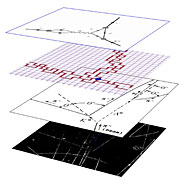- Number 360 |
- April 9, 2012
Supercomputing the difference between matter and antimatter

The distance scales incorporated
into the kaon-decay calculation
range from fractions of a meter
(bubble-chamber image, bottom),
to fractions of a femtometer
(Fenyman diagram of quark
transformations, top). This range
is similar to a comparison of the
size of a single bacterium with
the size of our entire solar system.
Using breakthrough techniques on some of the world’s fastest supercomputers — located at DOE labs and elsewhere — an international collaboration has reported a landmark calculation of a kind of subatomic particle decay that’s important to understanding matter/antimatter asymmetry. The research helps nail down the exact process of kaon decay, and is also inspiring the development of a new generation of supercomputers.
The present calculation — carried out by physicists from DOE's Brookhaven Lab, Columbia University, the University of Connecticut, the University of Edinburgh, the Max-Planck-Institut für Physik, the RIKEN BNL Research Center (RBRC), the University of Southampton, and Washington University — describes one aspect of how a kaon decays into two pions. This is the same subatomic particle decay explored in a 1964 Nobel Prize-winning experiment performed at DOE’s Brookhaven Lab, which revealed the first experimental evidence of charge-parity (CP) violation — a lack of symmetry between particles and their corresponding antiparticles. Exploring the precise details of kaon decay could help elucidate how and why today’s universe is composed almost exclusively of matter with virtually no antimatter to be found — one of the most profound questions in science today.
The new calculation builds upon extensive theoretical studies done since the first 1964 experiment and much more recent experiments done at CERN and at Fermilab. The accuracy of the measured experimental values for some very difficult to measure processes — which incorporate distances as minute as one thousandth of a femtometer (one femtometer is 1/1,000,000,000,000,000th of a meter, the size of the nucleus of a hydrogen atom) — allowed the collaboration to make a detailed comparison between these experimental observations and their calculation.
This process spans distance scales of nearly 18 orders of magnitude, from the shortest distances of one thousandth of a femtometer — far below the size of an atom — to the everyday scale of meters over which the decay is observed in the lab. This range is similar to a comparison of the size of a single bacterium and the size of our entire solar system.
The collaboration carried out the computation using the methods of lattice quantum chromodyamics (QCD, the theory that describes fundamental quark-gluon interactions), in which the decay is “imagined” as taking place within a lattice or grid of space-time points that can be entered into a computer. The quantum fluctuations of the decay are calculated by a statistical method that provides the most likely of the fluctuations as a result.
The calculations were performed under DOE’s Innovative and Novel Computational Impact on Theory and Experiment (INCITE) program on the Intrepid BlueGene/P supercomputer in ALCF at Argonne Lab and on the Ds Cluster at Fermilab, computer resources of the USQCD Collaboration. Earlier calculations were also done on Brookhaven’s QCDOC (for QCD on a chip) supercomputer, a prototype for IBM’s BlueGene series. Part of the analysis was also performed on the Iridis Cluster at the University of Southampton and the DiRAC facility in the UK.
[Karen McNulty Walsh, 631.344.8350,
kmcnulty@bnl.gov]
